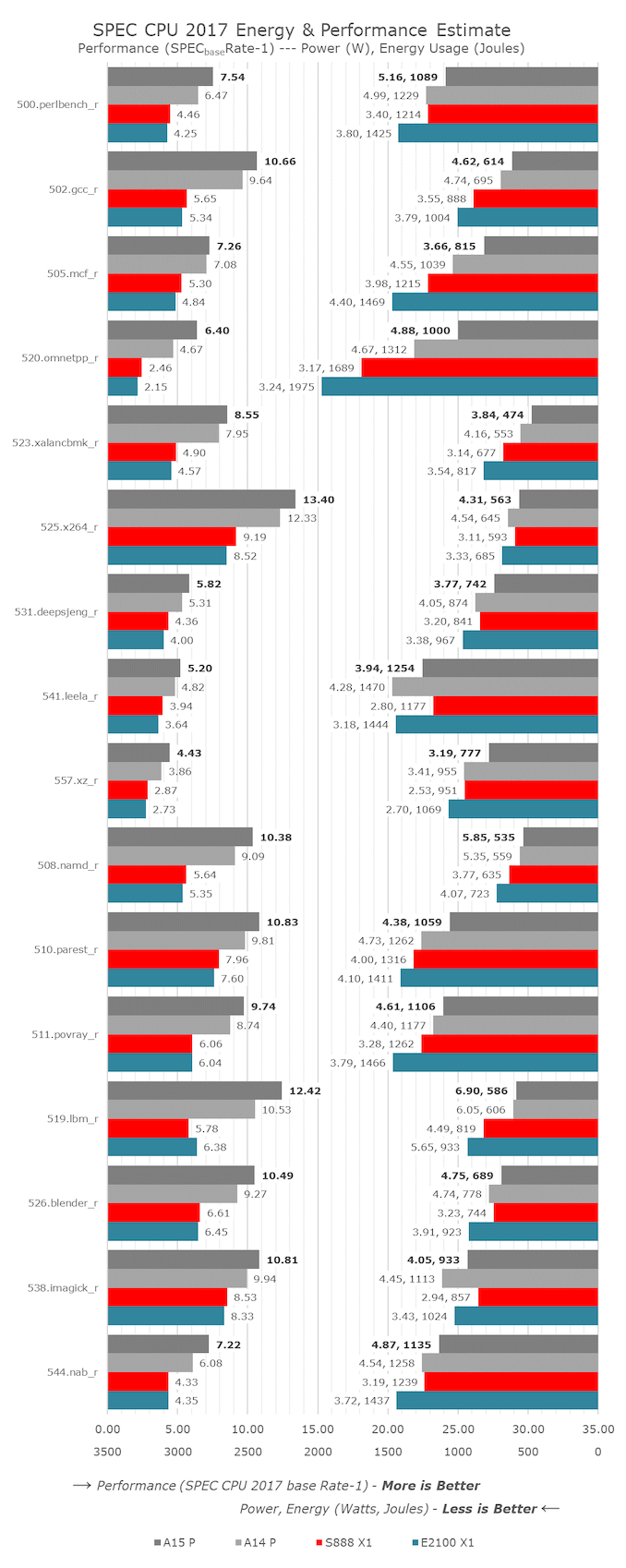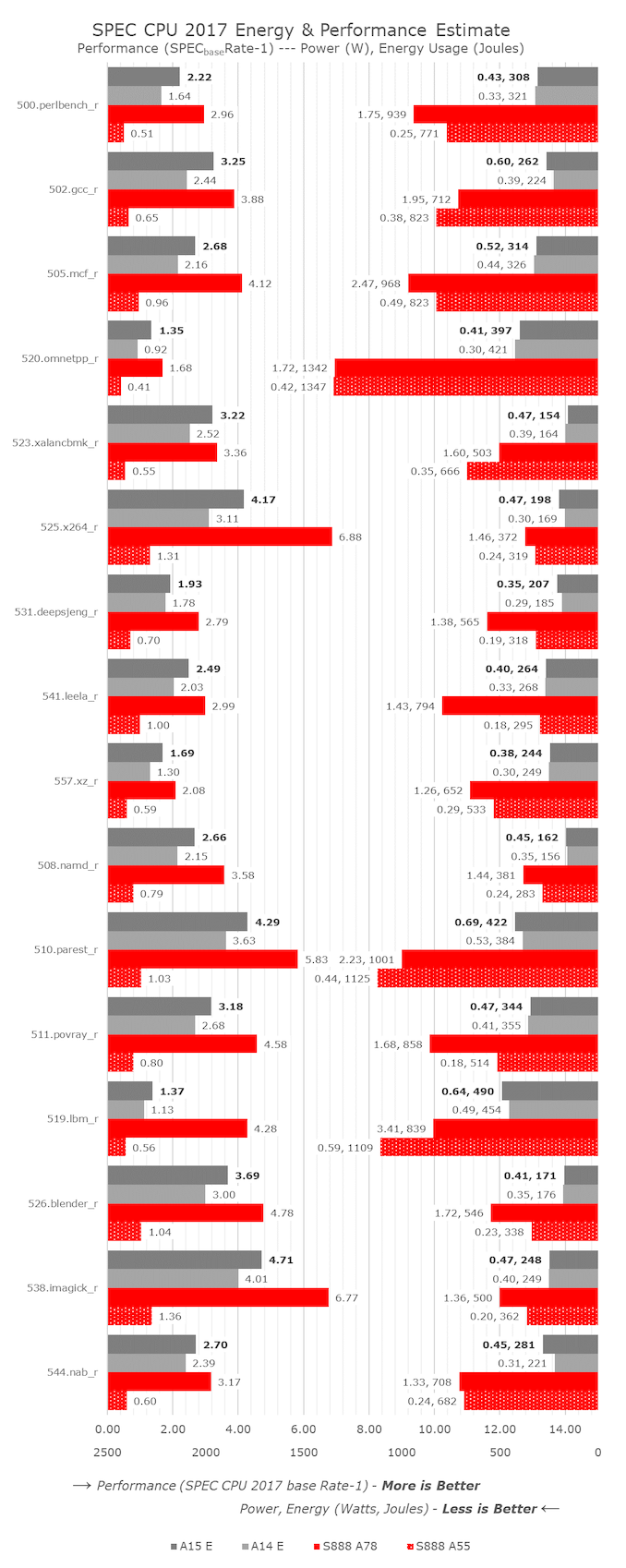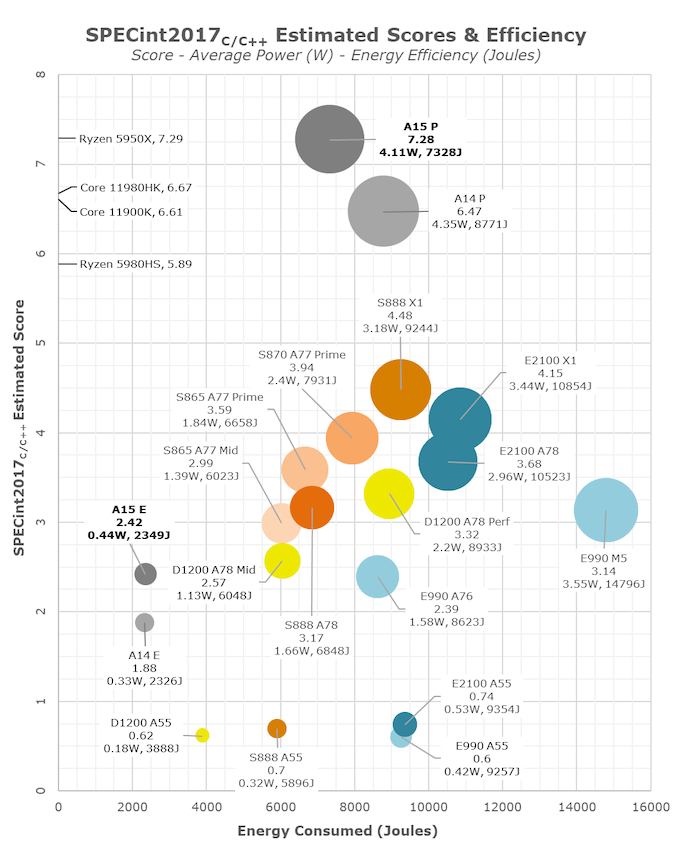The Apple A15 SoC Performance Review: Faster & More Efficient
by Andrei Frumusanu on October 4, 2021 9:30 AM EST- Posted in
- Mobile
- Apple
- Smartphones
- Apple A15
CPU ST Performance: Faster & More Efficient
Starting off with this year’s review of the A15, in order to have a deeper look at the CPU single-threaded performance and power efficiency, we’re migrating over to SPEC CPU 2017. While 2006 has served us well over the years and is still important and valid, 2017 is now better understood in terms of its microarchitectural aspects in its components, and becoming more relevant as we moved our desktop side coverage to the new suite some time ago.
One continuing issue with SPEC CPU 2017 is the Fortran subtests; due to a lacking compiler infrastructure both on iOS and Android, we’re skipping these components entirely for mobile devices. What this means also, is that the total aggregate scores presented here are not comparable to the full suite scores on other platforms, denoted by the (C/C++) subscript in the score descriptions.
As always, because we’re running completely custom harnesses and not submitting the scores officially to SPEC, we have to denote the results as “estimates”, although we have high confidence in the accuracy.
In terms of compiler settings, we’re continuing to employ simple -Ofast flags without further changes, to be able to get the best cross-platform comparisons possible. On the iOS side of things, we’re running on the newest XCode 13 build tools, while on Android we’re running the NDKr23 build tools.
In terms of performance and efficiency details, we’re swapping the graphs around a bit from now on – on the left axis we have the performance scores of the tests – larger bars here mean better performance. On the right-side axis, growing from right to left are the energy consumption figures for the platforms, the smaller the figure, the more energy efficient (less energy consumed) a workload was completed. Alongside the energy figure in Joules, we’re also showcasing the average power figure in Watts.
Starting off with the performance figures of the A15, we’re seeing increases across the board, with absolute performance going up from a low of 2.5% to a peak of +37%.
The lowest performance increases were found in 505.mcf_r, a more memory latency sensitive workload; given the increased L2 latency as well as slightly higher DRAM latency, it doesn’t come too unexpected to see a more minor performance increase. However, when looking at the power and efficiency metrics of the same workload, we see the A15 use up almost 900mW less than the A14, with energy efficiency improving by +22%. 520.omnetpp_r saw the biggest individual increase at +37% performance – power here went up a bit, but energy efficiency is also up 24%.
The smallest performance gains of the A15 are found in the most back-end execution bound workloads, 525.x264_r and 538.imagick_r improve by only 8.7%, resulting in an IPC increase of 0.6% - essentially within the realm of measurement noise. Still, even here in this worst performance case, Apple still managed to improve energy efficiency by +13%, as the new chip is using less absolute power even though clock frequencies have gone up.
The most power demanding workload, 519.lbm_r, is extremely bandwidth hungry and stresses the DRAM the most in the suite, with the A15 chip here eating a whopping 6.9W of power. Still, energy efficiency is generationally slightly improved as performance goes up by 17.9% - based on first teardown reports, the A15 is still only powered by LPDDR4X-class memory, so these improvements must be due to the chip’s new memory subsystem and new SLC.
Shifting things over to the efficiency cores, I wanted to make comparisons not only to the A14’s E-cores, but also put the Apple chips in context to the competition, a Snapdragon 888 in this context, comparing against a 2.41GHz Cortex-A78 mid-core, as well as a 1.8GHz Cortex-A55 little core.
The A15’s E-cores are extremely impressive when it comes to performance. The minimum improvement varies from +8.4 in the 531.deepsjeng_r, essentially flat up with clocks, to up to again +46% in 520.omnetpp_r, putting more evidence into some sort of large effective sparse memory access parallelism improvement for the chip. The core has a median performance improvement of +23%, resulting in a median IPC increase of +11.6%. The cores here don’t showcase the same energy efficiency improvement as the new A15’s performance cores, as energy consumption is mostly flat due to performance increases coming at a cost of power increases, which are still very much low.
Compared to the Snapdragon 888, there’s quite a stark juxtaposition. First of all, Apple’s E-cores, although not quite as powerful as a middle core on Android SoCs, is still quite respectable and does somewhat come close to at least view them in a similar performance class. The comparison against the little Cortex-A55 cores is more absurd though, as the A15’s E-core is 3.5x faster on average, yet only consuming 32% more power, so energy efficiency is 60% better. Even for the middle cores, if we possibly were to down-clock them to match the A15’s E-core’s performance, the energy efficiency is multiple factors off what Apple is achieving.
In the overview graph, I’m also changing things a bit, and moving to bubble charts to better spatially represent the performance to energy efficiency positioning, as well as the performance to power positioning. In the energy axis graphs, which I personally find to be more representative of the comparative efficiency and resulting battery life experiences of the SoCs, we see the various SoCs at their peak CPU performance states versus the total energy consumed to complete the workloads. On the power axis graphs, we see the same data, only plotted against average power. Generally, I find distinction of efficiency here to be quite harder between the various data-points, however some readers have requested this view. The bubble size corresponds to the average power of the various CPUs, we’re measuring system active power, meaning total device workload power minus idle power, to compensate components such as the display.
Apple A15 performance cores are extremely impressive here – usually increases in performance always come with some sort of deficit in efficiency, or at least flat efficiency. Apple here instead has managed to reduce power whilst increasing performance, meaning energy efficiency is improved by 17% on the peak performance states versus the A14. If we had been able to measure both SoCs at the same performance level, this efficiency advantage of the A15 would grow even larger. In our initial coverage of Apple’s announcement, we theorised that the company might possibly invested into energy efficiency rather than performance increases this year, and I’m glad to see that seemingly this is exactly what has happened, explaining some of the more conservative (at least for Apple) performance improvements.
On an adjacent note, with a score of 7.28 in the integer suite, Apple’s A15 P-core is on equal footing with AMD’s Zen3-based Ryzen 5950X with a score of 7.29, and ahead of M1 with a score of 6.66.
The A15’s efficiency cores are also massively impressive – at peak performance, efficiency is flat, but they’re also +28% faster. Again, if we would be able to compare both SoCs at the same performance level, the efficiency advantage of the A15’s E-cores would be very obvious. The much better performance of the E-cores also massively helps avoiding the P-cores, further improving energy efficiency of the SoC.
Compared to the competition, the A15 isn’t +50 faster as Apple claims, but rather +62% faster. While Apple’s larger cores are more power hungry, they’re still a lot more energy efficient. Granted, we are seeing a process node disparity in favour of Apple. The performance and efficiency of the A15 E-cores also put to shame the rest of the pack. The extremely competent performance of the 4 efficiency cores alongside the leading performance of the 2 big cores explain the significantly better multi-threaded performance than the 1+3+4 setups of the competition.
Overall, the new A15 CPUs are substantial improvements, even though that’s not immediately noticeable to some. The efficiency gains are likely key to the new vastly longer battery longevity of the iPhone 13 series phones – more on that in a dedicated piece in a few days, and in our full device review.













204 Comments
View All Comments
Nicon0s - Tuesday, October 5, 2021 - link
... modemLiverpoolFC5903 - Tuesday, October 5, 2021 - link
I understand that an apple SOC will probably cost 2-3 times at least considering the points you mentioned, but will it be a deterrent for OEMs? High end smartphones from the likes of Samsung and Sony are north of 1200 gbp, so they are pretty expensive anyway. Would a couple hundred quid added to the BOM and passed on the customer dent the overall sales of these top end smartphones? A customer who is paying 1400 gbp for the latest Note phone will probably be ok paying 1700 for a phone thats almost twice as fast. I personally would be happy to pay such prices for a high end droid with an A15 or even A14 soc , more so than paying that amount for a Z flip or something.Imagine the immense potential of such a device. One can dream.
To summarise, i dont believe cost will be a deterrent for OEMs, especially as customers are clearly willing to pay for cutting edge tech, as indicated by steady smartphone sales year on year despite a steep increase in prices of premium phones over the last 10 years.
michael2k - Wednesday, October 6, 2021 - link
I don't see how you could be close to correct.Worldwide Apple has 15% marketshare; lets pretend that of the remaining 85%, another 15% really would pay the extra an OEM would charge for the performance Apple offers.
In other words, a good chunk of Samsung's user base (since they have 18% globally) would be willing to pay a premium for iPhone level performance, even if it's a one year old SoC instead of the current year SoC.
The iPhone 11 Pro Max was estimated to have a $64 SoC; if Apple is to profit from selling it let us assume they charge $50, so that Apple sells each chip for $114:
https://www.techinsights.com/blog/apple-iphone-11-...
Qualcomm theoretically charges Samsung $57:
https://www.gsmarena.com/samsung_galaxy_note20_ult...
So if that means they can sell 200m chips at $114 and a $50 profit, they get $10b in profit a year and $22b in revenue from chip sales. That's healthy, and relevant since their 2020 revenue was $274b!
However, if they only got $5 per chip, their profit would only grow $1b and their revenue only by $2.2b, so clearly it wouldn't make sense to sell their chips for only $70. The question then is do you really think they could sell 220 million chips a year for $114?
And don't forget that this isn't going to be free for them, since they have to provide the drivers and basic supporting hardware for OEMs to use (essentially a reference design).
To compare to their other revenue streams, their smallest revenue stream right now is the iPad at roughly $30b a year:
https://www.apple.com/newsroom/pdfs/FY21_Q3_Consol...
So you have to expect Apple to aim for something comparable if they were to sell SoC (hence my original assumption of $50 profit per chip)
Speedfriend - Thursday, October 7, 2021 - link
For what most people use a phone for, the difference in speed is unnoticeable. I have had both an iPhone and Android as daily phones for at least 5 years and never felt one was noticeably faster than the otherNicon0s - Thursday, October 7, 2021 - link
>The question then is do you really think they could sell 220 million chips a year for $114?Impossible. The couldn't even get 200 million chips to sell.
Also in order to have a pure 50$ in profits the price for the SOC would have to be bigger than 114$. Apple also has to offer support for these chips, drivers and so on. Those are additional costs, some of them long term.
Ppietra - Thursday, October 7, 2021 - link
Nicon0s,Apple already "produces" around 250 million chips for itself, most of them usually at the most recent node process, leaving vacant most of the older production capacity... So it would be possible for Apple to produce extra 100-200 million older chips if it wanted to.
Nicon0s - Sunday, October 10, 2021 - link
You are missing a few important details. It takes apple 1 year or more to get their hands on over 200 million chips. It would be hard to double the production output at any given time in order to sell chips to other companies. Also the older production capacity is never vacant and it's always booked in advance.Also Apple wouldn't be able to sell an A13 at such a premium vs the latest Android SOCs. Maybe the SD898, exynos 2200 or dimensity 2000 won't be top in performance but they will sure offer better performance than an A13 SOC so I was obviously talking about the A15 in my comment.
Ppietra - Sunday, October 10, 2021 - link
don’t see what I am missing!the 200 million you commented about already represented 1 year production, that means what would be produced would be dispersed throughout the year.
Changing business models doesn’t happen overnight, so no one was talking about Apple selling 200 million by next year specifically. No one here was assuming nor can say that Apple would change things with no pre-established plan... that would be absolute nonsense.
What people are talking about is Apple establishing a business where it would sell 200 million a year and reap profits from it - it’s an hypothetical.
But I could put it in another perspective if Apple were planning to sell old SoCs by next year then it would already have planned its contracts to produce more.
Nicon0s - Saturday, October 16, 2021 - link
At least follow the conversion if you want to join in. He was specifically talking about selling 200 million chips to other companies and I specifically answered to that. The quote and my answer are in the same place.Also the 200 million is obviously in addition to Apple's own chips which they use for their products.
>But I could put it in another perspective if Apple were planning to sell old SoCs by next year then it would already have planned its contracts to produce more.
Even if it did volume would be much lower as most of the capacity will already be booked and those chips would still be quite expensive and obviously less competitive. The only way apple could get more is if they outbid. Realistically TSMC would not simply turn their back ro their other costumer just to only sell to Apple.
Ppietra - Saturday, October 16, 2021 - link
Nicon0s, It’s Apple that is already using that near 200 million manufacturing capacity. Once a new year comes it will be adding more manufacturing capacity with a new node... so no, there is no problem with volume, if it planned for it, Apple would be able to have those contracts because it would already be in the position where it was using that capacity. Apple already outbid others to be the first using it.